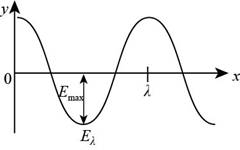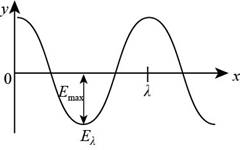
You may wish to review Sections 16.4 and 16.8 on the transport of energy by string waves and sound. Figure P33.46 is a graphical representation of an
Figure P33.46

(a)
To draw: The sketch a graph of the electric field at the instant
Answer to Problem 34.70AP

Figure (1)
Explanation of Solution
Given info: The expression for the average intensity of the wave is,
Introduction: The electric filed is a region around a charged particle within which a force would be experienced by other particles that may be attractive force or repulsive force.
Explanation:
The electric field in the figure is perpendicular to the magnetic field and the sinusoidal wave is travelling with the speed of light. The waves move on the positive x axis and the electric field is in the
The expression for the electric field is,
Here,
Substitute
The diagram of the electric field is shown below.

Figure (1)
(b)
Answer to Problem 34.70AP
Explanation of Solution
Given info: The expression for the average intensity of the wave is,
The formula to calculate the energy density in the electric field is,
Here,
Substitute
Thus, the energy density
Conclusion:
Therefore, the energy density
(c)
Answer to Problem 34.70AP
Explanation of Solution
Given info: The expression for the average intensity of the wave is,
The expression for the magnetic field is,
Here,
Substitute
The formula to calculate the energy density in the magnetic is,
Here,
Substitute
Thus, the energy density
Conclusion:
Therefore, the energy density
(d)
Answer to Problem 34.70AP
Explanation of Solution
Given info: The expression for the average intensity of the wave is,
The expression for the energy due to magnetic field at instant
The value of
Substitute
The formula to calculate the total energy density is,
Substitute
Thus, the total energy density in terms of electric field amplitude is
Conclusion:
Therefore, the total energy density in terms of electric field amplitude is
(e)
Answer to Problem 34.70AP
Explanation of Solution
Given info: The expression for the average intensity of the wave is,
The expression for the energy in the shoebox is,
Here,
Substitute
Integrate the above equation to find the value of
Thus, the amount of energy in the shoebox is
Conclusion:
Therefore, the amount of energy in the shoebox is
(f)
Answer to Problem 34.70AP
Explanation of Solution
Given info: The expression for the average intensity of the wave is,
The expression for the energy in the shoebox is,
The formula to calculate the power is,
Substitute
Thus, the power the wave carries through area
Conclusion:
Therefore, the power the wave carries through area
(g)
Answer to Problem 34.70AP
Explanation of Solution
Given info: The expression for the average intensity of the wave is,
The formula to calculate the intensity of the wave is,
Substitute
Thus, the intensity of the wave is
Conclusion:
Therefore, the intensity of the wave is
(h)
Answer to Problem 34.70AP
Explanation of Solution
Given info: The expression for the average intensity of the wave is,
The formula to calculate the average intensity is,
Substitute the average value as
Thus, the average value of the intensity is same as that given in the equation.
Conclusion:
Therefore, the expression of the result is same as that of the expression.
Want to see more full solutions like this?
Chapter 34 Solutions
EBK PHYSICS FOR SCIENTISTS AND ENGINEER
- A certain 60.0-Hz ac power line radiates an electromagnetic wave having a maximum electric field strength of 13.0 kV/m. (a) What is the wavelength of this very-low-frequency electromagnetic wave? (b) What type of electromagnetic radiation is this wave (b) What is its maximum magnetic field strength?arrow_forwardFigure P24.13 shows a plane electromagnetic sinusoidal wave propagating in the x direction. Suppose the wavelength is 50.0 m and the electric field vibrates in the xy plane with an amplitude of 22.0 V/m. Calculate (a) the frequency of the wave and (b) the magnetic field B when the electric field has its maximum value in the negative y direction. (c) Write an expression for B with the correct unit vector, with numerical values for Bmax, k, and , and with its magnitude in the form B=Bmaxcos(kxt) Figure P24.13 Problems 13 and 64.arrow_forwardConsider an electromagnetic wave traveling in the positive y direction. The magnetic field associated with the wave at some location at some instant points in the negative x direction as shown in Figure OQ24.12. What is the direction of the electric field at this position and at this instant? (a) the positive x direction (b) the positive y direction (c) the positive z direction (d) the negative z direction (e) the negative y direction Figure OQ24.12arrow_forward
- You are working at NASA, in a division that is studying the possibility of rotating small spacecraft using radiation pressure from the Sun. You have built a scale model of a spacecraft as shown in Figure P33.47. The central body is a spherical shell with mass m = 0.500 kg and radius R = 15.0 cm. The thin rod extending from each side of the sphere is of mass mr = 50.0 g and of total length = 1.00 m. At each end of the rod arc circular plates of mass mp = 10.0 g and radius rp = 2.00 cm, with the center of each plate located at the end of the rod. One plate is perfectly reflecting and the other is perfectly absorbing. The initial configuration of this model is that it is at rest, mounted on a vertical axle with very low friction. To begin the simulation, you expose the model to sunlight of intensity Is = 1 000 W/m2, directed perpendicularly to the plates, for a time interval of t = 2.0 min. The sunlight is then removed from the model. Determine the angular velocity with which the model now rotates about the axle. Figure P33.47arrow_forwardA dish antenna having a diameter of 20.0 m receives (at normal incidence) a radio signal from a distant source as shown in Figure P24.63. The radio signal is a continuous sinusoidal wave with amplitude Emax = 0.200 V/m. Assume the antenna absorbs all the radiation that falls on the dish. (a) What is the amplitude of the magnetic field in this wave? (b) What is the intensity of the radiation received by this antenna? (c) What is the power received by the antenna? (d) What force is exerted by the radio waves on the antenna? Figure P24.63arrow_forwardThe electric field of an electromagnetic wave traveling in vacuum is described by the following wave function: E =(5.00V/m)cos[kx(6.00109s1)t+0.40] j where k is the wavenumber in rad/m, x is in m, t s in Find the following quantities: (a) amplitude (b) frequency (c) wavelength (d) the direction of the travel of the wave (e) the associated magnetic field wavearrow_forward
- Suppose the magnetic field of an electromagnetic wave is given by B = (1.5 1010) sin (kx t) T. a. What is the maximum energy density of the magnetic field of this wave? b. What is maximum energy density of the electric field?arrow_forwardThe magnetic field of a plane electromagnetic wave moving along the z axis is given by B =B0(coskz+t) j , where B0=5.001010 and k=3.10102m-1 . (a) Write an expression for the electric field associated with the wave. (b) What are the frequency and the wavelength of the wave? (C) What is its average Poynting vector?arrow_forwardWhat is the intensity of an electromagnetic wave with a peak electric field strength of 125 Vim?arrow_forward
- (a) What is the frequency of the 193-nm ultraviolet radiation used in laser eye surgery? (b) Assuming the accuracy with which this electromagnetic radiation can ablate (reshape) the cornea is directly proportional to wavelength, how much more accurate can this UV radiation be than the shortest visible wavelength of light?arrow_forwardA dish antenna having a diameter of 20.0 m receives (at normal incidence) a radio signal from a distant source as shown in Figure P34.65. The radio signal is a continuous sinusoidal wave with amplitude Emax = 0.200 V/m. Figure P34.65 Assume the antenna absorbs all the radiation that falls on the dish. (a) What is the amplitude of the magnetic field in this wave? (b) What is the intensity of the radiation received by this antenna? (c) What is the power received by the antenna? (d) What force is exerted by the radio waves on the antenna?arrow_forwardAn electromagnetic wave with a peak magnetic field magnitude of 1.50 107 T has an associated peak electric field of what magnitude? (a) 0.500 1015 N/C (b) 2.00 105 N/C (c) 2.20 104 N/C (d) 45.0 N/C (e) 22.0 N/Carrow_forward
 Physics for Scientists and EngineersPhysicsISBN:9781337553278Author:Raymond A. Serway, John W. JewettPublisher:Cengage Learning
Physics for Scientists and EngineersPhysicsISBN:9781337553278Author:Raymond A. Serway, John W. JewettPublisher:Cengage Learning Physics for Scientists and Engineers with Modern ...PhysicsISBN:9781337553292Author:Raymond A. Serway, John W. JewettPublisher:Cengage Learning
Physics for Scientists and Engineers with Modern ...PhysicsISBN:9781337553292Author:Raymond A. Serway, John W. JewettPublisher:Cengage Learning Physics for Scientists and Engineers: Foundations...PhysicsISBN:9781133939146Author:Katz, Debora M.Publisher:Cengage Learning
Physics for Scientists and Engineers: Foundations...PhysicsISBN:9781133939146Author:Katz, Debora M.Publisher:Cengage Learning Principles of Physics: A Calculus-Based TextPhysicsISBN:9781133104261Author:Raymond A. Serway, John W. JewettPublisher:Cengage Learning
Principles of Physics: A Calculus-Based TextPhysicsISBN:9781133104261Author:Raymond A. Serway, John W. JewettPublisher:Cengage Learning
 Physics for Scientists and Engineers, Technology ...PhysicsISBN:9781305116399Author:Raymond A. Serway, John W. JewettPublisher:Cengage Learning
Physics for Scientists and Engineers, Technology ...PhysicsISBN:9781305116399Author:Raymond A. Serway, John W. JewettPublisher:Cengage Learning





